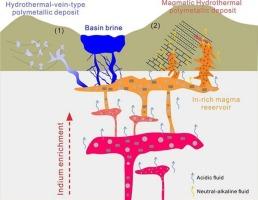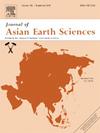含HF和hcl流体与花岗岩熔体相互作用过程中In、Sn、Cu、Cd、Fe、Pb、Zn的热液迁移:对In矿化的实验约束
IF 2.4
3区 地球科学
Q2 GEOSCIENCES, MULTIDISCIPLINARY
引用次数: 0
摘要
在闪锌矿中经常观察到丰富的铟(In)作为杂质元素,并与花岗岩相关的锡多金属矿床密切相关。岩浆-热液作用被认为控制着成矿作用;然而,潜在的机制仍然知之甚少。实验研究了花岗岩熔体在850℃、200 MPa条件下与0.5 ~ 2.0 mol/L含hf或0.5 ~ 11.0 mol/L含hl溶液相互作用过程中In、Sn、Cu、Cd、Fe、Pb、Zn的地球化学行为。结果表明In与这些元素之间存在显著的共变关系。其中,In、Sn、Zn、Cu和Cd在所有花岗岩熔体中均富集,随着HF浓度的升高,其浓度逐渐升高,但随着HCl浓度的升高,其浓度逐渐降低,而Fe和Pb则基本耗尽。这主要是由于In、Sn、Zn、Cu和Cd在酸性岩浆-热液体系中的热液流动性较低,促进了它们的同步富集。结果还强调了In的热液迁移率对pH值的强烈依赖性。酸性含氟或含氯流体可在花岗岩熔体中分别富集5 ~ 20倍或1 ~ 10倍的铅。相比之下,中性碱性含cl流体可能会导致In的大量耗损,耗损倍数高达1000倍。因此,含氟或含氯酸性流体的析出可能是形成富铅岩浆储层的必要先决条件。随后涉及中性碱性流体的活动,如外来盐水萃取或盐液析出,可以有效地将In从富In岩浆输送到热液流体中,从而促进了In的成矿作用。本文章由计算机程序翻译,如有差异,请以英文原文为准。

Hydrothermal mobility of In, Sn, Cu, Cd, Fe, Pb, Zn during interactions between HF- and HCl-bearing fluids and granitic melts: experimental constraints on In mineralization
Abundant indium (In) is frequently observed as an impurity element within sphalerite and closely associated with granite-related Sn-polymetallic deposits. Magmatic-hydrothermal processes have been proposed to govern In mineralization; however, the underlying mechanisms remain poorly understood. This study experimentally investigates geochemical behaviors of In, Sn, Cu, Cd, Fe, Pb, and Zn during interactions between granitic melts and 0.5–2.0 mol/L HF-bearing or 0.5–11.0 mol/L HCl-bearing solutions at 850 ℃ and 200 MPa. The results reveal a significant covariation relationship between In and these elements. Specifically, In, Sn, Zn, Cu, and Cd were enriched in all granitic melts, with their concentrations progressively increasing with higher HF concentrations but decreasing with higher HCl concentrations in both melts and solutions, while Fe and Pb were roughly depleted. This distinction is attributed to the low hydrothermal mobility of In, Sn, Zn, Cu, and Cd, which promotes their synchronous enrichment within acidic magmatic-hydrothermal systems. The results also highlight a strong pH dependence on hydrothermal mobility of In. Acidic F- or Cl-bearing fluids can enrich In within the granitic melts by a factor of 5 to 20 or 1 to 10 times, respectively. In contrast, neutral-alkaline Cl-bearing fluids may cause substantial depletion of In by factors of up to 1000 times. Consequently, the exsolution of acidic F- or Cl-bearing fluids could be an essential prerequisite for generating an In-rich magma reservoir. Subsequent activities involving neutral-alkaline fluids, such as exotic brine extraction or saline fluid exsolution, can efficiently transport In from the In-rich magmas into hydrothermal fluids, thereby facilitating In mineralization.
求助全文
通过发布文献求助,成功后即可免费获取论文全文。
去求助
来源期刊

Journal of Asian Earth Sciences
地学-地球科学综合
CiteScore
5.90
自引率
10.00%
发文量
324
审稿时长
71 days
期刊介绍:
Journal of Asian Earth Sciences has an open access mirror journal Journal of Asian Earth Sciences: X, sharing the same aims and scope, editorial team, submission system and rigorous peer review.
The Journal of Asian Earth Sciences is an international interdisciplinary journal devoted to all aspects of research related to the solid Earth Sciences of Asia. The Journal publishes high quality, peer-reviewed scientific papers on the regional geology, tectonics, geochemistry and geophysics of Asia. It will be devoted primarily to research papers but short communications relating to new developments of broad interest, reviews and book reviews will also be included. Papers must have international appeal and should present work of more than local significance.
The scope includes deep processes of the Asian continent and its adjacent oceans; seismology and earthquakes; orogeny, magmatism, metamorphism and volcanism; growth, deformation and destruction of the Asian crust; crust-mantle interaction; evolution of life (early life, biostratigraphy, biogeography and mass-extinction); fluids, fluxes and reservoirs of mineral and energy resources; surface processes (weathering, erosion, transport and deposition of sediments) and resulting geomorphology; and the response of the Earth to global climate change as viewed within the Asian continent and surrounding oceans.
 求助内容:
求助内容: 应助结果提醒方式:
应助结果提醒方式:


